

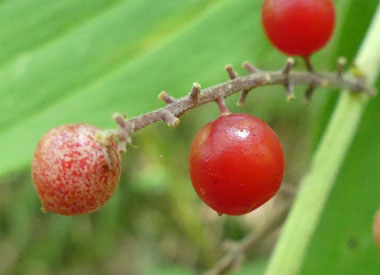
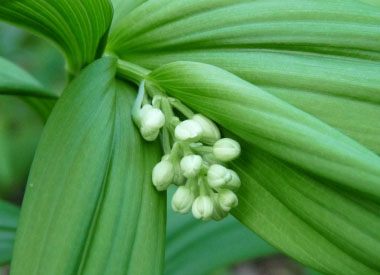
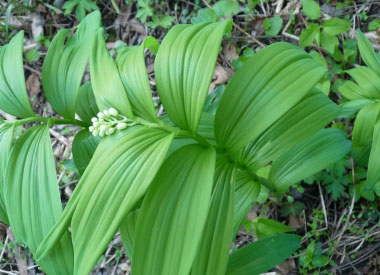
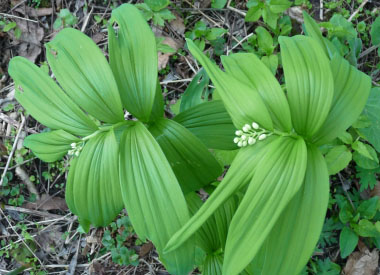
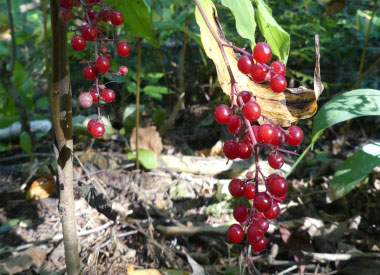
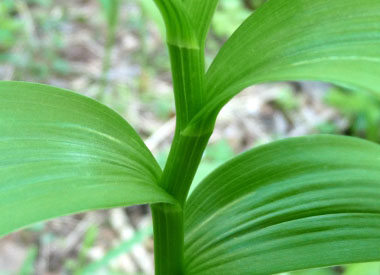


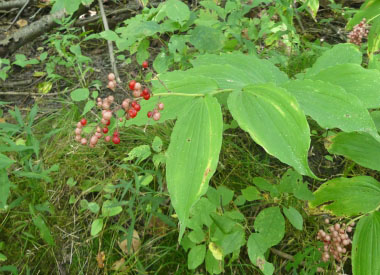
To support our efforts please browse our store (books with health benefits, etc.).
Overview: False Solomon’s seal (Maianthemum racemosum) and Solomon’s seal (Polygonatum spp.) are native woodland plants. Both plants produce long, arching stems. However, the flowering and fruiting characteristics are different. False Solomon’s seal produces creamy white flowers in fluffy clusters at the ends of the stems in spring. After flowering, small, pea-size berries develop that turn ruby red in late summer. Solomon’s seal produces bell-shaped, yellowish green to greenish white flowers in May or June. The flowers hang down in clusters from the leaf axils. The flowers are followed by marble-size berries which turn dark blue in late summer. Never eat any part of it's look-alike, true Solomon seal. False Solomon seal is in the Asparagus Family (Asparagaceae) and the lily family.
Distinguishing Features
This herbaceous perennial plant is unbranched and grows to about knee-high. The central stem is somewhat erect and ascending. Flowers (then berries) occur at the end of the plant. Flowers occur in a plume-like cluster of minute florets and transform into a “bunch” of ruby red berries (although they do not all ripen at the same time).
Flowers
Flowers are creamy white, small, and numerous. The stalks very short; in branched, egg or pyramid-shaped terminal cluster, strongly perfumed and showy when plants grow in clusters. Flowers become fleshy, round berries, showy, and measure 5 to 7 mm across.
 Fields
of Nutrition has medicinal benefits and vitamin/mineral content of False Solomon Seal.
Fields
of Nutrition has medicinal benefits and vitamin/mineral content of False Solomon Seal.
Leaves
Leaves are broad, elliptical, 7 to 20 cm long, alternating along the stem in 2 rows, with strong parallel veins and somewhat clasping bases; margins are smooth.
Height
False Solomon seal typically grows 60 to 90 cm tall and slowly spreads by thick rhizomes, often forming large colonies.
Habitat
This is a woodland plant that occurs in moist forests and along streambanks. They are widespread at low to subalpine elevations. They prefer well-drained soils that are neutral to slightly acidic. Some people have these in their garden as they can be grown from rhizomes or from seed (although the seed may take up to 18 months to germinate).
Edible Parts
The berries are edible and somewhat bittersweet. (Large quantities can have a laxative affect.) Young leaves are edible but relatively unpalatable. In traditional medicine the dried rhizomes can be used to brew a tea to treat coughs and constipation. In small quantities, cleaned rhizomes can be consumed.
Other Name
False Spikenard.
Similar Plants
Solomon Seal, which is poisonous. Click here for more information.  .
.
Winter Survival Food Handbook

PDF Plant Magazines
Types of Wild Food
Geographic Zones Seasons
Disclaimer
EdibleWildFood.com is informational in nature. While we strive to be 100% accurate, it is solely up to the reader to ensure proper plant identification. Some wild plants are poisonous or can have serious adverse health effects.
We are not health professionals, medical doctors, nor are we nutritionists. It is up to the reader to verify nutritional information and health benefits with qualified professionals for all edible plants listed in this web site. Please click here for more information.
Why Edible Wild Food?
- Food costs are rising
- Free, wild food is readily abundant
- Wild food adds nutrition to your diet
- Wild food can help treat various medical conditions





